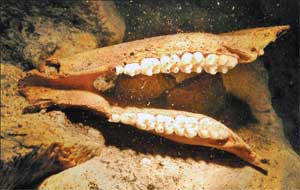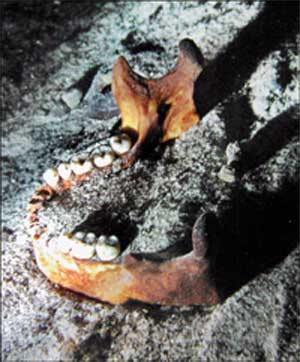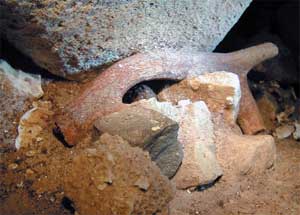On a sunny January morning in a remote
patch of scrub jungle in Yucatán State, I stood
knee-deep in the mouth of Xibalba, the Maya
underworld, tugging impatiently at my wetsuit
and scanning the crystalline pool for signs
my guide, Guillermo “Memo” de Anda, who
was somewhere below making a quick check of the conditions.
I was also keeping an eye out for the crocodile that state ecology
officials warned us about when they heard we were planning
on diving the site for the first time. They thought it was only
four- or five-footer, but they couldn’t be sure.
De Anda surfaced in a rush of bubbles. “It’s beautiful down
there!” he blurted, yanking off his mask. “So clear, and the size
of some of the pots! And the cave…” he shook his head, “it just
goes and goes and goes. Wait until you see it!”
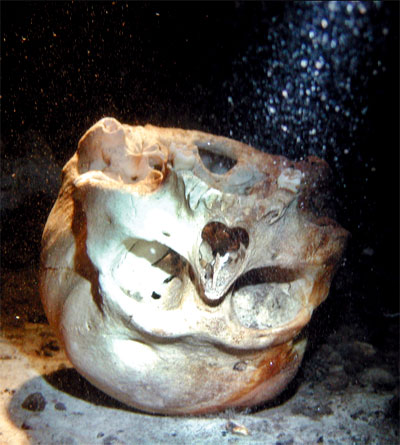 I flipped on my flashlight and popped my regulator into my
mouth as the warm, fresh water began to swirl up above my
head. It was time to check out the underworld for myself, crocs
be damned.
I flipped on my flashlight and popped my regulator into my
mouth as the warm, fresh water began to swirl up above my
head. It was time to check out the underworld for myself, crocs
be damned.
Thousands of entrances to Xibalba lie half-hidden in
the dense scrub of the Yucatán peninsula. These waterfilled
sinkholes, or cenotes (a Spanish corruption of the
Yucatec Mayan word for sinkhole, dzonot) are formed when
rainwater eats away at the peninsula’s fractured limestone
bedrock, creating underground caves. Eventually, the roofs of
these caves collapse, exposing subterranean water sources
ranging from small caverns that link into vast underwater cave
networks to large, sun-filled basins that can begin a hundred
feet below the surface.
These cenotes served not only as passageways to the afterlife,
but as lifelines for the present: In this riverless land, the
Maya depended on the cenotes to slake their thirst and irrigate
their fields. Great cities like Chichén Itzá and Mayapán centered
around life-sustaining cenotes, and small villages in the
Yucatec hinterland still rely on them. The cenotes are also the
abode of Chac, god of rain. To ensure that the rains would
come, Chac was appealed to with gifts and human sacrifice.
Deep in the interior of Mexico’s Yucatán State, where Maya is
still spoken in thatched-hut villages and you can find crocodiles in your cenotes, I spent a week accompanying de
Anda as he continued the formidable task of evaluating
the archaeological importance of the state’s
2,500-odd cenotes. A garrulous fireplug of a man
with a salt-and-pepper beard, the 46-year-old professor
of underwater archaeology at the Universidad
Autónoma de Yucatán in the picturesque city of
Merída, and father of two, once ran the most successful
dive shop in the neighboring state of
Quintana Roo. It was in cenotes there that he first
discovered the allure of the underwater world of the
Maya. He shuttered the shop and entered the staid halls of
academe when Francisco Fernandez Repetto, director of the
university’s anthropology department, asked him to establish
an underwater archaeology research center, the first of its
kind in Latin America, at Merída.
There’s not a croc to be seen as we quickly skim
down the cenote’s debris pile, the spill of boulder- to
fist-sized rocks created by the collapse of the cave’s
roof. Little light comes from the small surface entrance,
but in our initial burst of curiosity artificial beams scatter
about the walls and floor. We stop at
the end of the debris mound, 125
feet below the surface and some 300
feet back from where we entered.
Below us, the cave narrows into an
ethereal blue glowing tube that continues
down for another several hundred
feet. It beckons, but it’s not as
enticing as the promise of artifacts
nestled among the rocks. We fan out
and work our way back up the pile.
The first thing I come across is a
large chunk of charred Postclassic
(a.d. 900–1500) pottery. Someone else waves a light—a
signal for attention—around a large, Late Classic (a.d.
600–900) domestic pot.
Then we spot big, carved building
blocks tumbled amidst the limestone rubble.
The ceiling of the cenote is very low in some parts, and
our bubbles begin to dislodge a thick layer of sediment that
has formed there over thousands of years. It falls around us
like soft, fat flakes of snow, quickly reducing our visibility
from fifty feet to an arm’s length. Slowly working our way
back out of the cenote, we make the day’s discovery
halfway up: a small room off to one side containing the
half-exposed skull of a child and, in the center, an upsidedown
cranium of an adult.
So how did the skulls get into the side room? And does
the cranium belong with the adult jawbone, pelvis, and
other body parts we discovered on a subsequent dive, all a
good fifteen feet away in the main chamber of the cenote?
Most important, is this a sacrifice victim, or someone who
accidentally drowned?
“It appears that the Maya had two uses for cenotes,”
said de Anda as our van trundled out of the jungle after our
second dive on the site. “In ‘domestic’ cenotes, where people
drew their drinking water, you’ll find objects like pots,
animal remains, and organic construction material like
wood.” Human remains are usually a sign that a cenote
was used for ritual activity (see “Cenotes of Sacrifice,”
page TK). “Of course, there are always accidents,” he concedes,
“but when you have a number of remains, the possibility
that they’re all accidents is obviously not likely.” The
Sacred Cenote at Chichén Itzá contained at least 120 individuals,
many of them children, as well as adolescents and
disabled adults, says de Anda, who is currently analyzing
the remains from the Sacred Cenote under the auspices of
the Instituto Nacional de Antropología e Historia (INAH),
Mexico’s federal anthropology and history institute.
De Anda is pretty sure the deaths in Crocodile Cenote,
as we’ve nicknamed it, were no accident. (He has asked
me not to reveal the real names or locations of the cenotes
we visited for this article.) The human remains found so
far appear to be those of a very young child and a well-off
adult—the adult bones are strong and the teeth are in very
good shape. Children and high-status captive warriors
were the preferred sacrifice victims for Chac, de Anda
says.
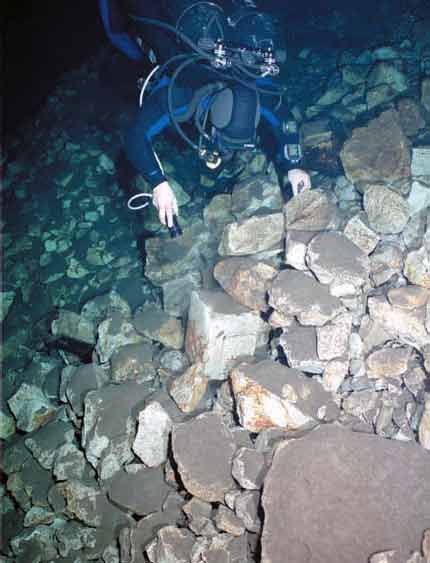 The front of the adult cranium also shows a considerable
injury, but one that most likely healed before death.
This may be another sign that the adult victim was a warrior.
The deer antlers and painted potsherds found nearby
with the human remains were perhaps associated with the
sacrifice ritual. There may be cut marks on the jaw bone,
but what appear to be marks may also just be sediment.
De Anda could bring the jaw back to the lab to confirm
his suspicion of cut marks. His work, however, primarily
involves nonrecovery surveys, meaning he does not remove
objects from the sites he visits. Rather, he documents his
discoveries with photographs and submits his reports to
the state offices of INAH and the state ecology department.
Any excavation whatsoever must be approved by
INAH, which zealously oversees all of Mexico’s underwater
archaeological sites.
The front of the adult cranium also shows a considerable
injury, but one that most likely healed before death.
This may be another sign that the adult victim was a warrior.
The deer antlers and painted potsherds found nearby
with the human remains were perhaps associated with the
sacrifice ritual. There may be cut marks on the jaw bone,
but what appear to be marks may also just be sediment.
De Anda could bring the jaw back to the lab to confirm
his suspicion of cut marks. His work, however, primarily
involves nonrecovery surveys, meaning he does not remove
objects from the sites he visits. Rather, he documents his
discoveries with photographs and submits his reports to
the state offices of INAH and the state ecology department.
Any excavation whatsoever must be approved by
INAH, which zealously oversees all of Mexico’s underwater
archaeological sites.
Of Yucatán State’s estimated 2,500 cenotes, de
Anda has examined about 120 since 1996. Some
are so remote that it can take three days to reach
them. Other cenotes are so deep that they require a 60-
foot rappel just to reach the water—and then there’s the
matter of getting back up.
Cave diving is among the most dangerous of all scubadiving
specialties because of the requirements of navigating
in dark, overhead environments. “Cenotes can be very, very
dangerous if you don’t dive in them with the right equipment
and the right training,” says de Anda, a cave-diving
instructor. “You have to make sure
you allow yourself enough air to get
back out of a cenote.
Diving instructors
trained only in open-water environments
have died in cenotes
because they run out of air. You can’t
simply rise up to the surface like you
can in the ocean. It’s also easy to die
from getting lost. People go in without
guide lines, or stir up the silt in
the bottom of the cenote and can’t
see a thing, and they panic.”
Because of the considerable
investment in time and money it
takes to become a bona fide cenote
diver, to say nothing of the physical
dangers involved, de Anda’s diving
support team for now consists of
only two cave-diving certified graduate
students, with two more working
on their certification. Seventeen students
have undergone underwater archaeological training
in the university program to date.
De Anda’s senior support diver is Diana Rivera, 25, a
petite woman with wide brown eyes who uncomplainingly
schleps through the jungle with equipment designed for
men twice her size. Over sangria one night after diving, I
asked Rivera, who is about to begin her master’s degree in
archaeology, what her boyfriend, also an archaeologist,
thinks of her cenote diving. “He thinks I’m nuts,” she
replied.
An important nondiving member of de Anda’s team is
Dionisio Orozco, a self-assured 54-year-old guide who
hails from a small Maya village west of Merída. De Anda
and Orozco met through the state ecology department
eight years ago and have worked together ever since.
Orozco seems to have a lead on every cenote in the surrounding
scrub jungle, and with his nephew, Pedro Tum
Ortiz, provides de Anda with the critical topside assistance
needed for diving in this difficult environment.
Finds in “Crocodile
Cenote” include,
clockwise from left, a
deer antler, a [TK] jaw,
and a human jaw, most
likely a healthy young
male. De Anda
believes it belongs
with a cranium found
15 feet away in the
cenote and shown on
page TK.
Orozco was the one who led de Anda to one of his richest
discoveries, a cenote in the middle of a major unexcavated
archaeological site, on property owned by an ejido, or
local community. On the day we dive it, we’re joined by two
occasional members of the support team, a Florida cavediving
couple de Anda met while training together at a
technical diving class. “We fell in love with this project, and
saw immediately that Memo needed help,” says Geoff
Young, a lanky, soft-spoken corporate lawyer, who with his
partner, real-estate developer and photographer Melisa
French, have helped de Anda explore
and document the cenotes over the
past year.
This cenote lies near the center of
the settlement, at the base of a deep
depression. Multiple hives of aggressive
African bees are tucked away in
the rock escarpment that hangs low
over the water, and we set up our
gear away from the site while Orozco
and Ortiz drive the bees back to
their hives with a pungent yellow
smoke from the metal tins they carry.
By the time we head down through
the bush to the cenote, the covered basin has filled with
drifting smoke. Adding to the atmosphere, Orozco walks to
the edge of the water, recites a short prayer to the supernatural
“owners” of the cenote and throws a pebble in the
water. He does this every time we are about to enter the
water. (To the modern Maya, these “owners” can take the
form of TKs called tzucans, gnomes known as aluxes, or
simply “bad winds” that cast illness.)
“We had a rash of bad luck at one point,” recalls French.
“Strange things were happening in the cenotes—bad
things, including equipment failures and injuries. Now we
make sure to have our Maya guides offer a quick prayer
before we enter a cenote.
You have to remember that these
are still sacred sites. And at some of these cenotes, you do
pick up vibes.”
I look around the dark, smoke-filled basin, quiet except
for the occasional hiss of a regulator and the low bee-hum
in the background. Then I poke my head underwater and
see the narrow, dark entrance to the main underwater
chamber off one side of the basin, obstructed by a series of
stalactites that formed when the water level in Yucatán’s
cenotes receded, most likely during the last few Ice Ages.
The effect is that of a gaping, fanged mouth. “Ready to
swim into the mouth of Chac?” jokes de Anda when I
come back up.
At the bottom of the debris mound in this dark, silty
cenote, I’m shown one of the stars of the site: a carved
Classic period (a.d. 250–900) glyph with a date, 3 Ix, one
of the twenty Maya days of the sacred year of Tzolkin.
Perhaps it’s a royal accession or construction date; de Anda
can’t be sure because the rest of the glyph is surrounded by
rubble and inaccessible. Moving other rocks away from it
is out of the question—de Anda’s admonition to look but
not touch reflects both the sanctity of these sites and the
basic credo of cave divers: Take nothing but pictures, leave
nothing but bubbles.
Moving back up the pile, I begin to notice a lot of construction
blocks and large columns. De Anda believes an
entire structure is in the cenote; either it was once at the
water’s edge and tumbled in over time, or it was deliberately
destroyed and thrown in. The other artifacts we find
seem to support his hypothesis that the cenote is in the
ceremonial center of the archaeological site. There are a
large number of haltuns(corn mortars), an appropriate
offering when beseeching the Rain God to look after your
crops. We also identify jaguar skulls, human bones scat
tered here and there between the rocks,
another glyph, several ornate carvings, and
orbs hewn from stalactites.
This cenote is at the top of de Anda’s list
of the ones he’d like permission to excavate.
The site surrounding it is the frequent
target of looters, and the interior of
the cenote itself is incredibly fragile. An
errant diver’s fin can send some of the
debris field tumbling, and de Anda worries
for artifacts like a delicate Early Classic
(a.d. 250–600) bowl, its unidentified
organic contents still half-spilled on the
rocks around it.
Cenotes pose a unique set of problems
to archaeologists who have spent a century
trying to recover artifacts from their
depths. “We have the terrible example of the Sacred
Cenote at Chichén Itzá,” says de Anda, referring to the
remarkable assortment of gold, jade, ceramic, and even
wooden, fabric, and rubber artifacts from the Late Classic
to the Postclassic periods hauled up from the sinkhole’s
murky depths during the first expedition to the site from
1904 to 1911.
“The artifacts from the site are very important,
but everything was just dredged up—it’s completely
out of context. So much information has been lost,” he
says. The considerable amounts of silt, combined with the
enclosed working environment, often preclude standard
open-water excavation techniques, while attempts to
pump cenotes dry have met with disastrous results.
Geologists estimate that water provides up to 80 percent of
a cenote’s structural support; when the water is removed,
the cenote can simply collapse.
“There are others who really want to go down and dig in
some of these sites,” de Anda continues, “but I’m one of
those archaeologists who says, Let’s wait a bit until we have
a little more technology to do the job right. What we really
need to do now is survey as many of these cenotes as we
can and really get a handle on what we have out there.”
This includes exploring the use of remote operated vehicles
(ROVs) to survey cenotes in addition to human divers (see
Archaeology Online for more on the potential for ROV
exploration of cenotes).
Then there is the problem of monitoring 2,500 remote
jungle sites. “Some argue that since we don’t have the
manpower to control the sites, we shouldn’t even discuss
the cenotes and what’s in them,” says de Anda. Instead, his
university, in conjunction with the state government, has
established a program to educate tourist guides on the role
of cenotes in Maya history. “It’s so important that people
realize cenotes are archaeological sites
with unspoiled access to a whole new
wealth of information on the Maya. The
artifacts in them need to be protected,” he
says. “These are not just places to go swimming
or scuba diving.”
Over the week, we dove a number
of cenotes de Anda and Rivera
were evaluating, from sun-filled
caverns to a narrow colonial-era Spanish
well on a cattle ranch with magnificent
rooms of enormous stalactites and stalagmites
in its depths containing Classic and
Postclassic ceramics and the remains of
three people.
Only one site appeared to be regularly
frequented by visitors. A scenic oasis popular with picnickers,
the cenote is a languid, lily-padded pool with a large,
cave-pocked rock escarpment rising above it. Around the
cenote is a looted Terminal Classic (a.d. 800–1000) site,
and de Anda suspects from the amount of construction
material down in the cenote that some sort of large structure—
a temple, perhaps—once towered above it.
Entering this cenote requires slipping through a narrow
passage under the escarpment, through a tangle of lilies and
fallen trees, and into a dark cave.
Swimming down the
mound on the initial leg of the dive, I make a quick orientation
with my light: How low is the ceiling? How irregular are
the walls? How many bones are below me? Then, at the bottom
of the debris pile, 120 feet down, the mouth of yet
another cave presents itself. I hover there for a minute,
transfixed, pointing my light
into this black yaw. How far
toward Xibalba does this go?
As seen at several other
cenotes we’ve dived, the artifacts
suggest this is a sacrificial
one: There are multiple
bodies in here, as well as small
funerary pots, which point to
secondary burials. The most
fascinating thing that I will
see all week—though I don’t
realize it at the time—is also
here: a few rocks and a tiny
animal bone in a wall niche
about 20 feet down from the
entrance, with a small ceramic
pot laying on the cave floor
nearby.
“So you saw the altar?” de Anda asks when we surface. He
suspects the bone was originally an offering inside the pot.
When I ask him how he’s come to this conclusion, he
describes an ill-fated excavation in Chiapas in the 1960s
where archaeologists attempted to pump a cenote dry. Before
serious collapses began to occur, a series of “altars”—niches
sealed with stones, were discovered at a depth of 30 feet.
Behind the stones were lidded pots containing bones as well
as small stones to keep the pots from drifting away.
This supports a theory that the Maya weren’t just throwing
objects and victims into the cenotes, but diving into
them and returning.
They must have also shuddered as they
swam into the mouth of Chac.
As we break down our equipment after the dive, I discover
this was the cenote where Orozco says he had an
encounter with the supernatural “owner” of the cenote.
Orozco recounts what happened. “De Anda was down in
the water while I was waiting up top. Suddenly I heard something
running through the brush and into the water. It was a
large serpent with a head that looked like a horse. It didn’t
scare me, of course. Such animals are the real owners of the
cenotes. They protect Chac.”
“Do they mind that we go in the cenotes?” I ask him.
“As long as you enter with good will, they do not mind,”
he replies.
“What could people do that
would make them angry?” I
press him further.
“When someone takes
something out of a cenote, or
when the creatures feel
threatened by you. Then you’ll
get very ill.” With that, Orozco
hoists a set of empty air tanks
on his back and heads back to
the van.
De Anda says he didn’t
notice the serpent that day.
“Maybe the creatures leave
me alone because I’m always
in the cenotes with good
intentions,” he laughs. “It’s a
good thing, too,” he adds, “because there are another 2,400
or so out there in the jungle that I still have to explore.”_
Spanish version


 I flipped on my flashlight and popped my regulator into my
mouth as the warm, fresh water began to swirl up above my
head. It was time to check out the underworld for myself, crocs
be damned.
I flipped on my flashlight and popped my regulator into my
mouth as the warm, fresh water began to swirl up above my
head. It was time to check out the underworld for myself, crocs
be damned. The front of the adult cranium also shows a considerable
injury, but one that most likely healed before death.
This may be another sign that the adult victim was a warrior.
The deer antlers and painted potsherds found nearby
with the human remains were perhaps associated with the
sacrifice ritual. There may be cut marks on the jaw bone,
but what appear to be marks may also just be sediment.
De Anda could bring the jaw back to the lab to confirm
his suspicion of cut marks. His work, however, primarily
involves nonrecovery surveys, meaning he does not remove
objects from the sites he visits. Rather, he documents his
discoveries with photographs and submits his reports to
the state offices of INAH and the state ecology department.
Any excavation whatsoever must be approved by
INAH, which zealously oversees all of Mexico’s underwater
archaeological sites.
The front of the adult cranium also shows a considerable
injury, but one that most likely healed before death.
This may be another sign that the adult victim was a warrior.
The deer antlers and painted potsherds found nearby
with the human remains were perhaps associated with the
sacrifice ritual. There may be cut marks on the jaw bone,
but what appear to be marks may also just be sediment.
De Anda could bring the jaw back to the lab to confirm
his suspicion of cut marks. His work, however, primarily
involves nonrecovery surveys, meaning he does not remove
objects from the sites he visits. Rather, he documents his
discoveries with photographs and submits his reports to
the state offices of INAH and the state ecology department.
Any excavation whatsoever must be approved by
INAH, which zealously oversees all of Mexico’s underwater
archaeological sites. 